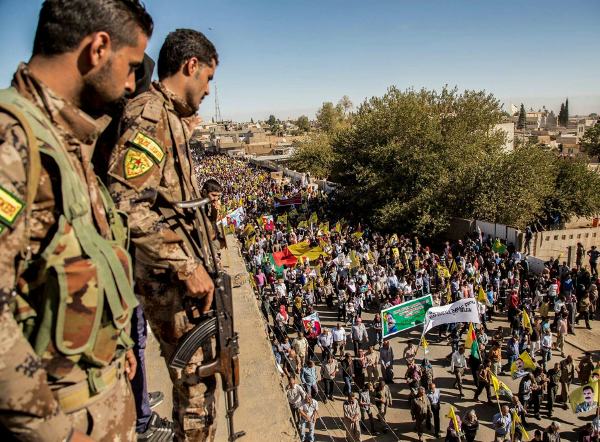This month marks the seven-year anniversary of the Syrian Civil War. The country, an arena of catastrophic destruction since March 2011, has witnessed a reign of terror from ISIS, proxy wars between major powers, and an incomprehensibly large-scale humanitarian crisis. Last fall, the international community celebrated the liberation of Raqqa, the self-designated capitol of the ISIS caliphate. With the fall of the caliphate began a new era of reconstruction in Syria.
Now, reconstruction efforts have encountered a new obstacle: growing tensions in northern Syria between U.S.-backed Syrian Kurds and the neighboring Turks. Also known as the Euphrates River Valley, this area of Northern Syria has recently evolved into the newest dimension of the seemingly endless conflict. And it is drawing in two key players, who also happen to be NATO’s two biggest military powers: the United States and Turkey.
Why are two NATO allies in potential conflict?
The U.S. has partnered with the Kurdish-led Syrian Democratic Forces (SDF) since 2016 in the fight to defeat ISIS. Supported by U.S. weapons and assistance, SDF forces have taken control of the northern Syrian cities of Afrin and Manbij, both of which border Turkey. Leading the SDF is the People’s Protection Units (YPG), a primarily Kurdish-based militia.
Turkey claims that the YPG has direct connections to the Kurdistan Workers’ Party(PKK), a group that has fought for Kurdish independence from Turkey for over 25 years. The Turkish government has designated the PKK as a terrorist organization. This connection has caused President Erdogan to explicitly condemn U.S. support of SDF, especially the U.S. promise to build a 30,000 strong border security force.
Now that SDF has gained control of Afrin and Manbij and continues to receive U.S. support, Turkey fears that the YPG will manipulate the situation to take control of the border and attempt to create an autonomous Kurdish state by aligning with Kurds inside Turkey.
To counter this action, Turkish forces have launched an offensive dubbed “Olive Branch” across the border. As a result, Kurds from throughout Syria have traveled to Afrin to defend the YPG against Turkish forces.
What does this mean for the defeat of ISIS?
Because SDF (and thus YPG) has been a key partner in defeating ISIS and in stabilizing liberated regions, the concentration of YPG forces in Afrin to fight the Turks could leave liberated areas unstable and unmanned, creating the threat of a power vacuum for ISIS to fill. According to an article in the New York Times, Gen. Joseph L. Votel, head of U.S. Central Command, explicitly stated in a testimony before Congress that “we need SDF to finish this fight.”
To ensure the lasting defeat of ISIS, the U.S. and the SDF must drive remaining ISIS fighters out of the Euphrates River Valley and stabilize the newly liberated territories, including Raqqa and the surrounding area. With YPG forces distracted in a fight against Turkish forces, this task becomes increasingly more difficult.
What are the dangers and implications of potential escalation?
The conflict between YPG and Turkish forces could result in catastrophic consequences. In addition to threatening the continued suppression of ISIS, the conflict forces the U.S. to support the SDF as a necessary partner against ISIS, or to honor a strategic NATO alliance with Turkey.
Even if the U.S. claims that supporting SDF is vital to the suppression of ISIS, clashing with Turkey would be disastrous for the Syrian conflict and the integrity of NATO. Further, it would require more U.S. troops on the ground.
Another potential scenario consists of Syrian government forces backing the SDF in the fight against Turkey. These forces of the Assad regime are backed by Russia and Iran. Though Russia has stated it will remain disengaged from the conflict with Turkey, if the situation continues to escalate, it could potentially evolve into a Syrian-Russian-Iranian coalition against the Turkish forces.
This could place the U.S. in an even trickier situation. If aggression increases between the potential Syria-Russia-Iran coalition and Turkey, and the U.S. honors its NATO commitments, it could find itself in direct conflict with the three-state coalition.
On the other hand, if the U.S. continues supporting SDF and Russia keeps its promise to stay out of the conflict in Northern Syria, this could drive Turkey into the hands of President Putin. As of now, there is a meeting planned between Erdogan, Putin, and Iranian President Hassan Rouhani for April in Turkey.
Best options moving forward
The U.S. should carefully disengage from this conflict. The multifaceted dimensions of partnerships, alliances, and potential ramifications must be handled carefully and strategically. Continued engagement in the Euphrates River Valley will force the U.S. into indefinite involvement.
Our relationship with Turkey must remain a priority. Pushing Turkey toward the Russians would be disastrous in both the short and long run, and harming the integrity of NATO would be cataclysmic to countering future threats. We should continue to reassure Erdogan and our Turkish counterparts that we do not support the Kurdish terrorist organization inside of Turkey and that we vehemently disapprove of all terrorist cells. In our conversations with Turkey, we should emphasize that the 30,000 strong border security force is to keep former ISIS fighters from fleeing the Euphrates River Valley—protecting both Syria and Turkey.
At the same time, the U.S. must also work towards stabilization in Syria to prevent the reemergence of ISIS. We should strongly instruct YPG forces in Afrin and Manbij to not engage with Turkish forces more than necessary, and we should encourage other Kurdish forces in Syria to stay in their respective cities. By framing the dialogue through ensuring YPG forces in Syria that they are necessary in the fight against ISIS, the U.S. can keep working toward stability.
The conflict in Syria often seems to fit the saying “two steps forward, one step back.” The U.S. must handle tensions between the Kurds and the Turks carefully to keep stabilization moving forward.

